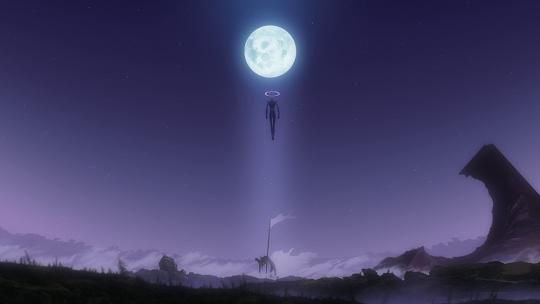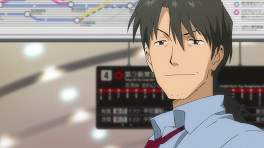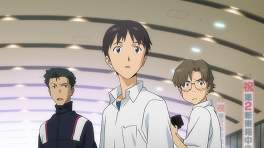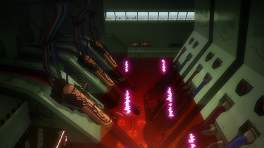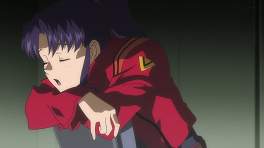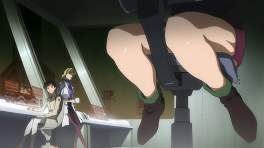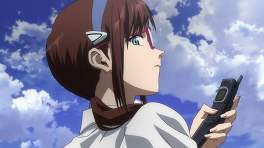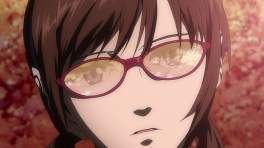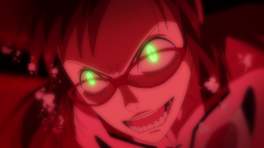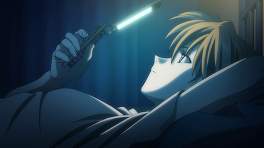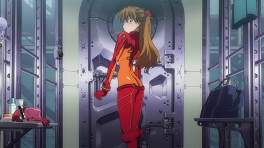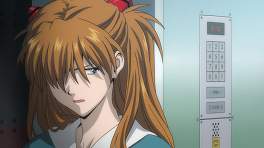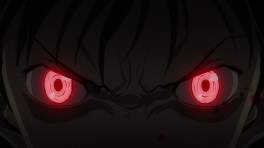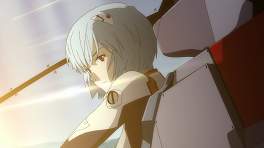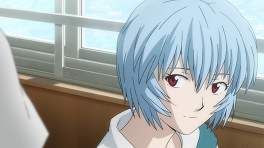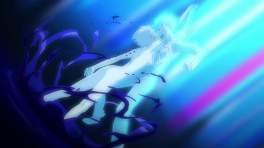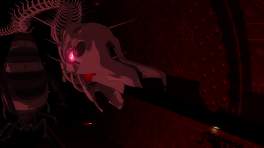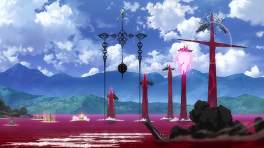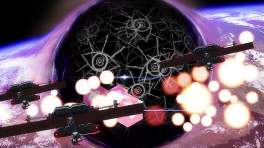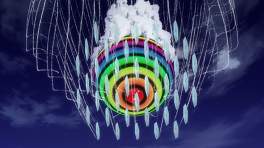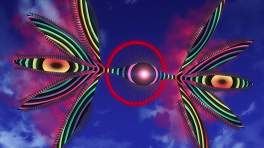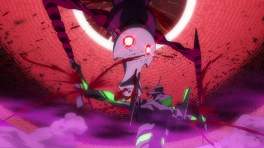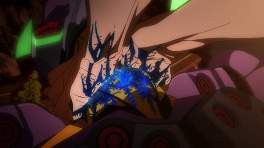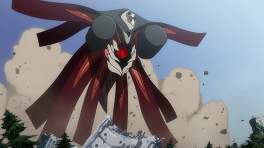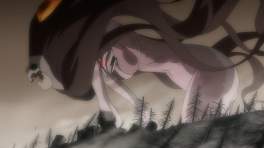I would strongly suggest not attempting to read this all at once, madness is sure to follow. It is meant as a coherent brain-dump: my take on different aspects of the film rather than fluid prose. Intrinsic knowledge of the original series, Death:Rebirth, End of Evangelion, the first Rebuild film You Are (Not) Alone and ancillary materials surrounding franchise is assumed. Because this is the last one I'll write, it has to be epic. Epic enough for sub-navigation:
- Response from a fan
- Differences from the original theatrical version
- Thoughts and theories
- Soundtrack
- Map
- Cataloguing
- Revision history
Response from a fan
Evangelion as a franchise exists outside normal rules for me - it is not subject to the whims of cynicism or common sense, it has successfully penetrated the part of my brain that is impervious to reason. Well-reasoned and vehement arguments against the series are deflected outright, so entrenched is the mythos and characters in my history. I am not however an unequivocally slavish fan, drooling over the latest piece of tat to be released from the GAINAX merchandising forges. Quality matters and though devotion often obviates niggles becoming issues, it created a solid foundation for the Rebuild project and it was not a foregone conclusion the project would deliver. But it has. In spades. A genuine and expansive addition to the Evangelion universe: this isn't a tawdry calendar or cameo in a Super Robot Wars game, this is a ground-up re-examination of what made the Evangelion TV series such a powerhouse and augmenting it for modern audiences - new and veterans alike.
Evangelion 1.11 was a love letter to fans who cherished the series, it played safe and kept relationships and characters familiar, upgrading the visuals where possible but maintaining an equilibrium between re-imagining and nurturing memories. 2.22 on the other hand changes this from the outset with Unit 05 and Mari - a new character in a new setting with an entirely new Angel to battle; no familiar camera angles or points of reference to cling on to, only Kaji reminding series stalwarts that this is still Evangelion. From there only apologetically familiar scenes are thrown in: Yui's grave, Kaji's delivery of Adam, Asuka's introduction, the story of Second Impact - all of these are still tweaked and altered: Shinji is more forthright with his father, Kaji and Gendou never refer to the delivery as Adam, Asuka now has a doll and there are four Angels shown during Second Impact. It isn't until a third of the way through that familiarity begins to sink in; even then events are more vicious, the results more hard fought and the damage - emotional and physical - more catastrophic.
This is Evangelion as the fans have wanted it: fluid and epic, subverting what they thought they knew about the mythos but never entirely undermining it. Never does the film forget however that while the fans are important, new viewers are equally so. Without the time available for the labyrinthine psychoanalysis that characterised the latter half of the TV series, it has plucked the most salient points and made them core to the experience, blending them into a three-act movie that doesn't scrimp on balls-to-the-wall action and suspense. 2.22 is a heady blend of cosmopolitan religious terminology, broken characters, violent aggressors, ambiguous interlopers and a pace that rarely lets up for air. Complementary to what is present is what it represents: all too aware that it is the middle child of a quadrilogy it expands on enough from the first film to surpass its status as a sequel, meanwhile deepening the mystery in preparation for the finale - satisfying yet enticing.
Evangelion 2.22: You Can (Not) Advance is a landmark visual feast, supremely accomplished on its own and important to more than just the legion of franchise fans. If it represents what is to come in the finale, there is much to look forward to.
Differences from the original theatrical version
The first main alteration is an extra scene after Asuka's introduction; in the original theatrical cut it went from Shinji on the floor being emasculated by Asuka to Kaji's cryptic dialogue with Gendou and Fuyutsuki. The recut version includes a padding scene where Shinji and Kaji briefly cross paths in the Togendai Chuo station.
The second additional scene is after Rei's dip in Central Dogma and after her meal with Gendou; the theatrical cut was succeeded by talk of repairing the Evangelion units. The recut version has a series staple, an entry plug test scenario with some Rei ogling from Shinji and various words said by an evidently bored Misato.
Various other scenes have had their animation and visuals tweaked, however the differences are by no means the pace changing that was evident in the transfer from the theatrical version of 1.0 to 1.11.
Thoughts and theories
Mari
The prevailing theory regarding Mari is that she is a cash-in, that GAINAX constructed her to sell more merchandise and to provide fan-service. While I agree there is no doubt a team of accountants rubbing their hands together with glee, the entire Rebuild project is a cash-in. One could potentially construct and argument that Evangelion somehow required a remake or sequel but that makes her, as someone more erudite than myself put it, a cash-in within a cash-in, a cash-in fractal if you will. Her existence, at least so far, seems more pragmatic for she represents a side to the Evangelion universe that wasn't present in the TV series: someone who plainly enjoys piloting; she says as much to Shinji after she is thrashed by the 10th Angel: "So there's actually someone out there who wracks his brains about whether or not to pilot EVA".
Her personality takes the best parts of Asuka's incarnation in the TV series - gutsy, capable and pragmatic - and throws in a dose of raw animalism - her actions during Unit 02's Beast Mode and her predatory body language when landing on Shinji speaks volumes; similarly in the aftermath of that battle as she speaks to Shinji, her exhaustion could almost be seen as post-coital afterglow although this crosses uncomfortably into Freudian concepts of sex and penetration...
Regardless, as Asuka's mental degradation is being sped up and made more blatant, there is little time for her brand of chaos explored in the TV series which leaves a pleasantly sized niche for Mari to fill. The danger of course is that she is written in as fan-fiction for Shinji which would lamentably place her on the same level as Mana from the Girlfriend of Steel video game; her interactions with the other characters will be the real test of her inclusion. Given her introduction and actions so far, it's not outside the realm of possibility that she is an antagonist and will fundamentally oppose the existing children; this would fit in with the combative national relationship the different NERV branches have in the films.
By the end of 2.22 she is still very much a cypher, her motivations and affiliations are still obscured; from her conspiratorial opening, mention of using an adult to get what she wants, through to her reactivation of Unit 02 in obvious violation of the Vatican treaty. Whether she is a rogue element or a tool of the EU or Russia sent to infiltrate the Japanese NERV agency is still up for debate and until her motives are made apparent she will remain a visually pleasing interloper.
Asuka
Not introducing Asuka until the second movie was a risky proposition when her story in the TV series is so integral to Shinji's quest for identity, even more so when Asuka's own story is a reflection of Shinji's. Relabelling her from Soryu to Shikinami seems an odd step to take, however it reflects her subtly altered motives. Whereas before she was isolated and her ego tied entirely to that of the Evangelion, now she opens up more readily to both Shinji - literally jumping into bed with him - and Misato - when speaking over the phone before the Unit 03 test. Asuka is keen to point out that her abilities, not her family connection let her be a pilot which infers that her mother does not have the same job as she does in the series: working as a scientist on the Evangelion project.
In a way she is given a bum deal in the Rebuild project especially given her previous importance: barely an hour of on-screen time the worry is that her story will be ignored in favour of the burgeoning Shinji and Rei romance. Her removal from the plot comes immediately after her reconciliation with Misato - an interesting turn of events given their fractious relationship in the TV series but understandable now that Asuka has not had Kaji to fawn over and seems to lack a strong male presence in her life.
Though still alive, her place in the story is now completely unknown. She and Mari are definitely counterparts, while Asuka was alone and wishes to fight alone, she grows to understand the need for other people; Mari meanwhile is entirely without friends in Japan and fights alone, going as far as cutting off all outside communication when battling the 10th Angel. Key points are changed now though, Asuka has not suffered the mind rape the series' 15th Angel subjected her to, her relationship to Shinji supplanted by Rei, her mentally disturbed mother no longer haunting her thoughts. Her part in the third movie is assured according to the preview, however apart from a face off against Mari, at this point there seems little place for her any more. It's unlikely this will be case though given her following, but whether it will be a competent integration or fan pandering is another matter.
Shinji and Rei
It's impossible to cover either Shinji or Rei when both are intrinsically linked in the Rebuild story. The series after all was Shinji's story and here it is no different. He is different thought: more assertive, more upfront about his motives for piloting the Evangelion, and crucially more willing to interact with other people. Rei is initially confused by the attention shown by Shinji and after he gives her lunch, she makes a conscious decision to grow - the shy smile she shows when returning to school, saying her speech needs to improve says volume about her outlook. 2.22 is the film when Shinji begins to take what he wants, not for anyone else, the most critical being his decision to retrieve Rei from the 10th Angel. In a complete reversal from his borderline catatonia in End of Evangelion, he reaches out to a torpid Rei, egged on by an ebullient Misato - he very nearly damns the entire human race for his decision, but that's not a conscious decision unlike EoE.
The devil is in the details though, Shinji's fight with the 10th Angel a key example as Misato releases the catapult locks, but it is Shinji who forcibly kicks the button to trigger it. Minor but significant, Rei shares a similar transformation. Still emotionless, she gradually begins to unfurl and show a concern for others - setting up Gendou and Shinji's meeting with dinner, wishing Asuka good luck before the test, forcibly throwing Mari from the N2 mine blast. Most telling though is in the lift with an enraged Asuka who extols her dislike for Rei's doll-like nature by going in for a slap - only for Rei to block it. A complete reversal from the series, it's a conviction that supersedes her usual passiveness and indicates she is willing to change, to advance.
The pivotal moment for the two of them though is when Shinji has forced his way into the core of the 10th Angel, screaming for Rei to come, and as she reticently reaches out for his hand, Shinji grabs her and pulls her close to his chest. This motion isn't without its consequences though with the two seeming to merge into Unit 01 - their hearts becoming literally intertwined - and with the Third Impact prevented with Kaworu's intervention, it's not known what will become of the two. Rei has appeared in Shinji's dream sequences on the train before so it's likely the two will share that dreamscape. In the series' canon though Shinji merged with Unit 01 after the 14th Angel Zeruel, if the same happens with both Shinji and Rei, considering Rei is a partial clone of Yui, Shinji's mother, who is also Unit 01's soul (according to the series) - the result could be very interesting indeed.
Sequel versus remake
The main question posed by the Rebuild project is whether it is, as the name suggests, a remake of the series or a "sequel", fitting within the canon of Evangelion lore. The latter is a more enticing prospect and there are many tidbits sprinkled throughout the second film which suggest this, primarily from Kaworu who says that "this time" he will make Shinji happy. Ignoring the obvious homo-erotic overtones to the phrase, it infers that he has tried and failed to make Shinji happy before.
The most telling element to suggest a sequel over a straight remake however is Tabgha base, situated on the moon which is bisected by a conspicuous red streak. Kaworu is seen to awaken from a series of coffins in the first film and the easiest explanation for the streak is from the End of Evangelion film which sees the giant Rei figure spray blood when Shinji chooses individuality over a collective, causing her to decay and crumble. There are hints in the name of the base as well: Tabgha being a place that in Christian religious lore that supposedly saw the miracle of loaves and fish as well as the fourth resurrection of Jesus Christ, almost fitting with the coffin Kaworu awakens from. This pitches Kaworu as a messianic figure, possibly meant to guide Shinji and other children towards their future however without further exposure to Kaworu's personality, this is entirely speculative.
Most of all though is the notion that making it a sequel is, to fans at least, a more promising proposition. "Canon" is a very fluid term and is in the eye of the beholder but the possibility exists "in universe" given Yui's last words as Unit 01 floated away at the close of End of Evangelion. She spoke of Unit 01 becoming an arc for the knowledge of humanity; from there it's not hard to postulate about the nature of the Dead Sea Scrolls which SEELE have apparently constructed their plans from and so forth; again however, without further information rather than oblique and enigmatic utterances, these ideas can only be charitably called speculation.
Angels
Questions still remain on the exact chronology of the Angels, with many from the series missed out or renumbered. What is known is prior to the series, three unknown Angels were encountered and there are twelve angels in total - from Gendou in the first film. Defeating the 3rd (by Mari) and 10th in the second film means there are two left and two to reveal depending on whether Lillith (either on the Moon or the fake in Terminal Dogma) is counted and whether Kaworu is still considered an Angel.
The Angels themselves are mostly redesigns of their series counterparts so the falling angel (Sahaquiel), infesting angel (Bardiel) and super-powerful angel (Zeruel) playing out very similarly. Asuka quickly defeats another Angel upon her introduction which although aesthetically new, is likely based upon the spider angel (Matariel). The first Angel of the movie that Mari defeats is the 3rd Angel and the events at Bethany base take place chronologically prior to the first movie. Its design is unlike most anything seen in the series and has yet to be given a canonical name.
The masterstroke however comes from the 10th movie Angel which combines both the series' 14th (Zeruel) and 16th (Armisael), the latter of which in the director's cut of the series took on Rei's form after infecting her. Cunningly, there is a similar effect with Asuka when Unit 03 is inhabited by the 9th Angel which ostensibly combines three angels from the series, primarily the 13th (Bardiel) and 15th (Arael) which attacks Asuka's mind from space, as well as some properties of the 11th (Iruel) with its ability the spread and infect. The latter is a stretch given the 9th Angel's innate properties, what is interesting to note however is that during the infection of Unit 01, the humanoid arms can bee seen leaking the blue substance but with staples covering the tears in the flesh.
As per the series, many of the Angels reflect the mental properties of the children fighting them, especially so when it comes to the AT field which is given more substance in 2.22 than ever before. The best example of this is the 10th Angel which Fuyutsuki specifically refers to as a "rejection type", demonstrated by its intense AT field - not allowing anyone close - as well as the shielding of its core when Rei and Mari finally break through. Fitting that it should be combated by an infiltrator no one knows and a pilot who closes herself off from other people.
Plot
With whispered portents of Asuka being an "important" subject and the next movie preview mentioning the Children of SEELE, it's entirely possible Mari, Shinji, Rei and Asuka are the chosen four . This would make sense if Kaworu is an Angel and would tie in with the four figures seen during Second Impact - going by the series' logic, all of the potential pilots were conceived/born at the same time as Second Impact which makes for a neat soul-transference theory.
Ignoring the sequel / remake debate, the canonical history of the movies remains much as it was in the series. So Second Impact still happened at the South Pole, Misato was still saved by her father, Yui still inhabits Unit 01; however instead of the embryonisation of Adam - the winged giant - four figures (each with a different chest marking, one with a dot in the centre of their forehead) are seen which are referred to in the preview at the end of the first movie as Lilim+ - the Lilim being the in-universe way of referring to the children of Lillith, humans, and supposedly the 18th Angel. If they are indeed human "spirits", it would make sense for them to inhabit human bodies - namely the children. The question then is: how does Rei and ultimately the bones of the small man Kaji refers to as the Lost Number fit into this? If Gendou's plan remains the same as the series - he wishes to be able to control Third Impact and guide humanity's evolution - then Rei remains the perfect vessel for that and his plan can proceed unhindered. He mentions Nebechadnezzer when looking at the embryonic sample although how this fits in with the terminology of the story is as yet unknown.
Alongside the four figures during the Second Impact montage is the image of four lances which are identical to the Lance of Longinus used in the series. In the End of Evangelion the mass produced units wielded faux lances, however Kaworu uses a lance to prevent Third Impact in the epilogue of 2.22 and we see a covered lance being transported during the construction of Unit 06 on the Moon. It's possible the lances have some sort of special properties for each of the four children - kind of like kill switches - although why there would be a lance each is up for debate. What is clear however is that Kaworu is more than likely not one of the four chosen children, the next movie preview shows him standing on a floor mural in front of four shadows, implying he is outside the select few of SEELE's children.
SEELE itself seems to be keeping with their original plan to make Unit 01 a vessel to lead humanity to the next stage of evolution: the Human Instrumentality Project. SEELE mentions "ceremonies" they must perform in preparation, this could possibly be reference to one of the most obscure phrases of the series: the Red Earth Purification ceremony which is supposedly the cleansing of the "red earth" - Adam in the original series. Whether this is what they are referring is, like so many points, up for debate.
Themes
The key to the themes of both Rebuild movies is in their titles: You Are (Not) Alone and You Can (Not) Advance. The former is especially true for Shinji who despite reaching out to people like Rei, is betrayed by his father and shuns the world; his feelings are best summed up prior to the battle with the 9th Angel where he says without Misato, Asuka or Rei to back him up, he's not sure he can do it; Asuka displays a similar mentality when reaching out to Misato prior to her near fatal excursion in Unit 03.
Humanity and its meanings are another running theme, the key to this being the Evangelion units and their humanoid features. Many different types of humanity at both ends of the scale are seen: Shinji and Rei as well as Misato and Kaji show a very soft and fragile relationship with each other, gradually learning of their affection and drawing closer - Misato more clumsily than Shinji; the Evangelions however show the limits of what can be called human, the Dummy Plug demonstrating unchecked violence and barbarity, Mari's beast mode with Unit 02 showing a no less vicious but more controlled fury, Unit 01 and its ascension past the limit of humanity to godhood.
One of the secondary themes of the TV series carries over with the concept of children versus adults, or youth against adulthood - a common thread in anime especially when produced by GAINAX. The interplay between Misato and Shinji is mostly absent in 2.22 apart from Shinji's departure after the Dummy System incident, it is the talk between Misato and Asuka which gives the most clues, about how Asuka still has many things to experience. The core idea of adults pushing their ideals onto children is still prevalent though and will be interesting to see whether this will be expanded upon or left as subtext.
Miscellaneous
Acheron - Mentioned at the beginning of the film during Mari's introduction, Acheron seems to be a base built over a black sphere which could well be the nexus of Second Impact or it could be Lillith's egg as seen in End of Evangelion which was beneath the geofront in Japan. Depending on the spelling of Acheron, the meaning could be wildly different: "Acharon" is a Hebrew term for the Acharonim who are Jewish law men from the 16th century onwards; "Acheron" meanwhile is a river in Greece which has mythological connections to the River Styx and the land of the dead. The latter is the more likely explanation and would tie in with the black sphere being Lillith's egg, or as termed in the End of Evangelion, "Guff's Door" or the room of souls. One of the computer screens in Bethany base at the start of the film gives the spelling of "Akron" which is the name of numerous places throughout the United States and Europe, the alternative spelling for the same sound being "Acron" which turns out to be a Greek physician. In all likelihood the Styx meaning is the intended one and the screen spelling is incorrect.
Kaji - Just as crafty and charismatic as his TV series counterpart, the burning question is whether he will survive until the end of the movies or whether he will suffer the same fate - killed by a faceless gunman. If the next movie preview is anything to go by, it seems strife is in his future but he is at least willing to fight against it.
State of the world - There is a lot more texture given to the world of Evangelion within the movies, despite their shorter running time than the series. A lot is said about the indigenous wildlife and food systems when the group are in the Marine Preservation Sanctuary: that the oceans are now barren, devoid of life and only the sanctuary provides a home for endangered species of marine life. Likewise the mention of 90% synthetic meat implies that livestock is in short supply although vegetables don't seem to be. The geofront is given a lot more attention and its interaction with Tokyo-III - the cultivated fields and watermelon growing by Kaji is certainly an odd use of the land beneath a military fortress city.
NERV Branches - The different branches of NERV seem to be: 1st - Japan, 2nd - North America and 3rd - Europe. The 2nd branch was wiped out in a near cataclysmic disaster with Unit 04, the explosion seeming to envelop almost all of the continent. There is a lot more friction between the different branches of NERV, with Maya mentioning that even Ritsuko was in the dark regarding the Dummy System implying they may work towards the same goals but NERV is as still at the mercy of corporate hierarchies. What is interesting to see is the same matte black pyramid in North America when Unit 03 is being transported implying there are satellite bases - much like Matsushiro is to Tokyo-III - all around the globe. This could explain the Golgotha base that supposedly built the Dummy System and the mention of Betania / Bethany base.
SEELE - SEELE's symbol invokes Christian mythology again with the seven eyes once again present - supposedly the seven eyes of God - as well as a snake wrapped around an apple implying the Garden of Eden story and the apple of knowledge. The text on the monoliths they speak to Gendou through says: "Uberm Sternenzelt richtet Gott. wie wir gerrichtet", the last word misspelled and should likely be "gerichtet" which gives a rough translation from German to English as "We judge, as God judges from the starry expanse" - fitting for SEELE's self-imposed position as arbiter of humanity's evolution.
Soundtrack
Shiro Sagisu was the composer for the Evangelion TV series and produced a soundtrack that was widely praised for its use of orchestral, classical pieces and so highly thought of that it was the subject of a concert in 1997 recorded at the Bunkamura Orchard Hall and later released as the album "Symphony of Evangelion". The music for the Rebuild project is still helmed by Sagisu and features some familiar tracks, albeit with a much richer orchestral tone; most interesting however are the additions. The first soundtrack limited these to incidentals and the stunning Angel of Doom which plays during Shinji's second shot at the 5th Angel (Ramiel); however the second balances fresh with familiar and features some absolutely stunning tracks.
The most iconic of which are used during the most intense of scenes, beginning with Mari engaging the third angel to the stirring At The Very Beginning, starting sombre and subdued but gradually building to a crescendo as the Angel approaches the target area of Acheron. It isn't until the 8th Angel begins its descent that the score picks up again, starting with Destiny, another slow burning track that incrementally raises the volume of the choir chants until giving way to a lone soprano singer. This is immediately followed by Fate, bold and expansive, it accompanies the three Evangelion units as they work together to take down the 8th Angel. The multi-tonal choir is back, this time asking what the future holds as drum beats grow in intensity, striking a marching, war-drum backing until the release with the Angel's defeat.
A number of mellow piano tracks round out the slower moments, referred to as Tranquillite, parts play throughout the film but a large chunk is played during Kaji's reminiscing of Misato's Second Impact past. The 9th Angel is accompanied by familiar tracks from the series, this time brought to life with electric guitar backing and a far richer orchestra. It is the sublime battle with the 10th Angel that provides the best evidence of Sagisu's talent, starting with perhaps my favourite of the entire score, In My Spirit. Played as denizens of Tokyo-III scramble to evacuate, the 10th Angel decimates the city and infiltrates into the Geofront. As Mari faces it down, Keep Your Head Above The Mayhem comes in strong, followed shortly after by The Final Decision We All Must Take as she activates the Beast mode of Unit 02. After a brief pause, the pace picks up again with Carnage as the Angel heads towards the command centre and is intercepted by Shinji. It is the collection of these four tracks which elevate the soundtrack far beyond anything Sagisu has composed before and places it soundly in the upper echelons of movie scores, especially when combined with favourites such as Sin From Genesis as Unit 01 re-awakens.
Not all is as rosy as these tracks would imply though. During two key points during the movie, the score switches from grand and orchestral to twee and reedy, discarding all notions of atmosphere and opting for a child-like, school play score. In one regard it is fitting with the themes of the movie and effective in its juxtaposition of innocence alongside horrific violence; on the other is the concern that with such a catalogue of brilliant tracks to choose from, re-using such a divisive one seems antagonistic; especially so during the climax of the movie when five glorious tracks have come in rapid succession only to be broken by a small girl singing and Shinji's grunting. It's not without precedence however with Sagisu using Komm, süsser Tod (Come Sweet Death) and Thanatos - If I Can't Be Yours in End of Evangelion; once however is more than enough and it makes one wonder what plans Sagisu has for future releases.
Regardless, to call the score anything other than ferociously brilliant would be an understatement. It impresses on its own but when paired with the visuals and pathos of the movie, the result is astounding: moving and evocative, superlatives can not do it justice.
Map
Various locations mentioned within the movie match up with existing places in Japan, those that are mentioned are marked in the map below.
View Evangelion 2.x locations in a larger map
Cataloguing
Going through the minutiae of the film with a fine tooth comb is a surefire way of destroying the carefully crafted pace and doesn't reveal any hidden secrets. The level of detail that has gone into many aspects however is immense, from the computer interface screens to incidental background details, picking out some of them is my love letter to the animators and CG artists who painstakingly designed and implemented them.
Unit 05, Mari and the Third Angel
- Mari's plug suit helmet: EVANGELION PROVISIONAL
- Unit 05 boot up sequence:
##EVA Unit 05 PROVISIONAL BOOTUP AND ENTRY SEQUENCE
Version 2.6.21.5 (e50801107vmsv.local)
===PROJECT EVANGELION subsys Version 4.4.0===
E.V.I. SYSTEM Firm Rev: 2.6.21
Manufacture: IPEA 270 [69054117] 5 (ARMEv5PE), cr=0000
Features=0x806040<TWB6,UC,BLR,WTRR,PEXA,EXTC> [active]
MD: real mem = **268353536122590 (255 TB) [active]
MD: avail mem = **253071315256860 (241 TB) cache wb
Built *1107 zone lists. Total pages: *40641701
fxp0: <CHECK ALL CONNECTED D/A DEVICES> port 0x3400-0xA43F
Standing by... - Unit 05 post-bootup sequence: Internal Power Supply Mode Disabled / External Power Supply Mode Verification Complete / External Power Supply Mode Bootup
- Computer screen: Target proceeding through Styx Main Shaft bound for Akron / Critical Situation: Level 3 / Experimental Subject: 3rd Angel - Containment Breach
- Computer screen: Eva Unit 05P Proceeding through Styx Main Shaft
- Computer screen: Experimental Subject: 3rd Angel / Breaching Containment Measures
Shinji and Gendou at Yui's grave and Asuka's introduction
- Yui's grave: died 2004, unknown when her birthday is, always obscured by the flowers
- Gendou's VTOL: serial number UN-0257-01, decal "NERV Headquarters Commander 1"
- Misato's Car numberplate: 33-10
- Ship numbers: 142 > 145
- Sagami bay: exists and is located between the Izu and Miura peninsulas (thanks to WAHa.06x36 for this)
- Document that appears on Misato's in-car computer prior to Unit 02's deployment:
NERV 3rd Branch Official Letter
The issuer of this document herebt request all relevant parties involved to not hiunder the holder of this mission directive in his / her duty to accomplish the mission and to provide all possible aid and assistance needed to successfully execute the mission.
Mission Directive / TASK 02
From: General James Henderson Supreme Commander NERV 3rd Br.
Mission Execution Date: To be determined by the Mission Director
Mission Execution Location: Any geographical locality with high probability of hostile intrusion by an Angel/s.
The name "James Henderson" doesn't appear to have any relevance. 3rd Branch is evidently Europe as 2nd Branch is North America.
- Aeroplane carrying Unit 02: U4002-01 (EU NERV)
- Crossbow gun used by Asuka: Uberelectron-[x] Project Evangelion NERV EU MM-144
- Unit 02 is apparently to be transported via Route 1 from Sagami which is a river
- Touji, Kensuke, Misato, Rei and Shinji are standing on a sign reading "EXIT Emergency Only 266", Platform E-09
- Touji, Kensuke and Shinji walk up an escalator with the sign "Inclined Rail Route Line" behind them
- A "BOA Juice" advert can be seen on the ticket machine
- The station is labelled as Togendai Chuo Station, a real station
Kaji's introduction and Tabgha moon base
- "Lost Number" suitcase: Catalog Number 000-0000-x, Specimen Name: [Persian], CODE: [blank]
- Lost Number suitcase Persian text is "Nebechadnezzer" (thanks to Indra for this)
- Sign in the corridor Misato is initially standing in: 3rd Central Mainframe Room - Caution to Magnetic Field
- The room Ritsuko and Kaji are in have server numbers: R-033 - R-044, R-085, L-023 - L-051
- Ritsuko using a Panasonic toughbook [Product link]
- Cargo truck as Shinji walks home: NERV CARGO, number plate 11-07
- Asuka's cargo boxes have stickers: Luftpost (Air Mail), Deutsche Post, PP VP, "JAPAN", "Do not stack, this end up, Fragile"
- It is around 1831 when Asuka moves in
- Shinji's cargo box is labelled: Kuroshio Logistics - a fictional company, however Kuroshio a body of water
- KHI diggers outside Rei's: No-2, 250SA (KHI construction)
- Rei's medicine packet barcode number: (05)04119350070021
- Misato still drinks Yebisu beer
- Trains: Shin-Manazuru (currently 35.15650, 139.1387), Tokyo-3 City Monorail, 1701
- Building behind Maya as she walks to work: Tokyo-III Standard Structure
- Road bridge Shinji walks over as he goes to school: Tokyo-III Kyu-sengokuharakogen 5
- Misato's report: NERV 03 O[x], Tactical Opera[x] / Evangelion Un[x] / First field combat dep[x] / Against the 7th Angel // NERV 03 Operation Researc[x]
- Misato's top: Concorde Bristol 233
- Tabgha base 01 -04 - Tabgha is supposedly a Christian miracle site
- Blindfold on Lillith / Unit 06: Project Evangelion
Marine preservation centre
- Marine preservation centre in shape of Hebrew Sephirot / Sephira
- Plaque: International Environmental Agency - Japan Marine Ecosystem Preservation Research Organisation
- Decontamination stages: Exit To / Decontamination / J.M.E.R.R.O. / Long Wave Irradiation Decontamination Room / In Use / Level-01
Exit To / Decontamination / Organic Compound Electrolytic Dissociation Sterilization Pool Treatment Room / In Use / T-(D3)EX-4 / L.C.L. Administrative Area
Exit To / Decontamination / Organic Compound Electrolytic Dissociation Re-Sterilization Pool Treatment Room / In Use / Level-02 / T-(D3)EX-4 / L.C.L. Administrative Area
Exit To / Decontamination / Organic Compound Electrolytic Dissociation Re-Re-Sterilization Pool Treatment Room / In Use / Level-03 / T-(D3)EX-4 / L.C.L. Administrative Area
Entry Procedure Irreversible / All Sterilization Procedures Complete / People - 5 Confirmed / Birder - 1 Confirmed / Entry Permitted (Access Restricted to Stage 3 Decontamination Area) / Level-03 - Random pipe work: 902-1, 1792, TL-7-2, 13-2, No. 25
- Pen-Pen's collar: EX-293A Pen^2
- Floating empty pack: Green tea / NERV / Instructions: 150ml hot water (60degreesC) / Net Weight: 1.3+-0.1g / Best If Used: half year / 8909-GT0033
- Marine preservation centre ringed by towers: A-20, A-33, Shinji and Kaji stand between A-35 and A-34
- Artificial beach: panels - E-439 - E246
8th Angel
- Mauna Kea Observatory - a working observatory
- Computer simulation: Original Trajectory / Ground Zero Probability Spread / 99.9999% / Predicted Impact Location +- 0.000000 point
- Computer simulation: Object: 8th Angel / Impact Event Simulation / Estimate of Blast Damage from 8th Angel Impact Event
- Explosion from the Angel would cause a crater to reach 15km below sea level
- Order D-17 given by Misato: general evacuation
- Computer simulation: EVA-00/02/01 / Intercept Zone / 8th Angel Impact Point / Hypothetical GROUND ZERO / Angel Impact Strike Interception Tactical Simulation Pattern A/B/C
- Floor marking: [Japanese] ESE
- New Gotenba substation - an old station exists
- Computer text: 8th Angel Incoming / Operation In Progress
- 8th Angel starts at 20km above, falls to 12km
- Evangelion power panel: Active Time Remaining: / Main Energy Supply System / External/Internal/Auxiliary / Stop - Slow - Normal - Racing
- Misato asks initially for emergency course 605 to 675, then subsequently 1027 to 1078
- The panels lifted for Unit 01: Tokyo-III / MABSS-605 (639) / Multipurpose Adjustable Blast Shield Structure B
- Raised building numbers: 1073, 1074 / Danger structure may rise suddenly / Lock Unit W-02 / ELS
- Drowned buildings: TOKYO-III Standard structure NW-0155, 0572, 0582
- Mission summary: Mission Record: A-02 / Case: A1701 / TOKYO III Districts / Compiling Damage Reports
Misson: Record E-00 / Case: A1701 / Eva Unit Status: / EVA-00 / Moderate Damage / Pilot: / Rei Ayanami / Health: Normal / All Vitals Normal / Advanced Synchronization Induced Feedback Rate: 38.6% / Object: / EVA-00 w/ Pilot
Misson: Record E-01 / Case: A1701 / Eva Unit Status: / EVA-01 / Extensive Damage / Pilot: / Shinji Ikari / Health: Normal / All Vitals Normal / Advanced Synchronization Induced Feedback Rate: 68.4% / Object: / EVA-01 w/ Pilot
Misson: Record E-02 / Case: A1701 / Eva Unit Status: / EVA-02 / Minor Damage / Pilot: / Shikinami Asuka Langley / Health: Normal / All Vitals Normal / Advanced Synchronization Induced Feedback Rate: 2.07% / Object: / EVA-02 w/ Pilot
Mission Record: A-02 / Case: A1701 / GEOFRONT / Upper Bulkhead Area / Compiling Damage Reports
Stand down / 8th Angel Exterminated - Communication from Gendou and Fuyutsuki: External Comm / Standard Line / Online Classified / SOUND ONLY / Selected / From: Deputy Cmdr. Fuyutsuki/Cmdr. Ikari / To: NERV HQ 1st Command Center Colonel Katsuragi / Live / Transmission Recorded / Recording Saved To MAGI 01 Databanks
- Relay to Shinji: External Comm / Standard Line / Online Classified / Aduio Feed: Online / Visual Feed: Offline / SOUND ONLY / Selected / From: Commander Ikari / Live / Relay: NERV 1st Cmd Center
- Emergency Cage 99 used for retrieval
Cooking and Unit 03
- Lunch time on the second school day: 12:38pm
- Rei's central dogma collar: REI-02
- Test plug monitoring: Monitored Object: TEST PLUG 00 OBJ-SYNC TEST / Pilor: R. Ayanami / All Vitals: Normal Harmonics: Normal / LIVE / ONLINE / MV:K00
Monitored Object: TEST PLUG 01 OBJ-SYNC TEST / Pilor: S. Ikari / All Vitals: Normal Harmonics: Normal / LIVE / ONLINE / MV:K01
Monitored Object: TEST PLUG 02 OBJ-SYNC TEST / Pilor: S. Asuka Langley / All Vitals: Normal Harmonics: Normal / LIVE / ONLINE / MV:K02 - Shinji's view of Rei: External Comm Standard Line / ONLINE / Audio Feed: Online Visual Feed: Online / Object: Test Plug 00 Pilot - Rei Ayanami / LIVE / Feed Origin: Test Plug 00/Sync Check S03
- Numbers on train: 2-8, 1-05
- Circular support / scanner: NERV SERIAL No 32.1202
- Vending machine: UCC Good Coffee Smile (exists: http://www.ucc.co.jp/eng/)
- Coffee from Kaji: UCC Coffee Milk & Coffee
- Sign in corridor: North Exit / Elevator Hall / 300-412 / Emagency Only Pull / Fire Extinguisher
- Misato's new car number plate: 1971, other car number plate: 35-16
- Paraphernalia around Asuka while she cooks: Washing up liquid - SPARKLY / Pure Maple Syrup / Nescafe / DEATH
- Computer report: GROUND ZERO / Base Vaporization Process Breakdown and Analysis
- VTOL that lifts Unit 03: UN-03
- Unit 03 transported in a crucifixion pose
- Kensuke and Shinji sit between signs 5 and 6 while Touji plays basketball
- Basketball scene likely paying homage to the storyboarded but never animated scene in End of Evangelion with Touji after being released from the hospital when he piloted Unit 03
- Writing on SEELE monoliths: Uberm Sternenzelt richtet Gott. wie wir gerrichtet
- Writing around Unit 02's freeze: Project Evangelion - 02 Front-01, L-01
NERV / Keep Out / Above the line is jurisdictional area of NERV / Keep Out / Below the line is jurisdictional area of UN IPEA / UN IPEA / 03/02
CON-E1/2/3/4/8/9 / 12.0TON - Sign as Asuka enters the lift: Caution to Magnetic Field
- Various notes about Asuka: Left handed bandages, gets off at B-12, Camera above Rei and Asuka in lift
- Shinji's radio: Cougar No 7 / Power on off / Dual Lift Push / Set time / 120 Minutes On-Off Timer / Indicator / Tuning - Battery / FM Wide Band / FM-MW-SW Tuned RF Amplifier / On Off Loudness / On Off DX Local / FM AFC MW / FM SW MW / Low - High / National Panasonic / IC FET Integrated Circuit / Tone News Music / Volume Min Max
- Books on Shinji's shelf / desk: English Course / Kurosx
9th Angel
- Sign on the Dummy Plug: DMYSYS / Golgotha Base Built
- Misato and Hyuuga standing near signs: LEFT 07, 10m, above LEFT 08
- Neon signs: Darts bar, Chips, Yoshidaya (could be a ryokan), 2F Used Clothing 12:00-23:00 nico, B1F, 0422-4, 5F 0-6588, Stolts, Cut
- Entry plug transport behind Misato's car: NERV truck, R580, 03 number plate - Entry Plug Transport Rig / NERV 2nd Branch USA - R-01 to R-10
- Real places mentioned: Matsushiro (test base) and Odawara Hospital
- Asuka's call to Misato: Connected with secured line / Sound Only Selected - NTT docomo
- Products Asuka uses: Die hochsten te[x] / Bodycreme Kamille
Facemis[x] / Picowater / Original trea[x]
- Computer report: Monitored Target Subject: EVA-03 Assigned TEST Pilot / Verifying Neurological Linkup: Synchronization Rate Severe Fluctuation
- Computer report: Monitored Moidel Structure: Interior of EVA-03 Entry Plug / Status Interior Array Breaking Safety Level / Verify and Correct Plug Depth Status Immediately
- Status: Explosion Accident Request
- Computer report: Pattern Analysis: A / Image: A1107 / CAM:008
Pattern Analysis: B / Image: B5510 / CAM:032
Pattern Analysis: C / Image: C1991 / CAM:012
Pattern Analysis: D / Image: D0913 / CAM:046
Object: Matsushiro Temporary Cage - Hyuuga briefs Shinji: External Comm / Standard Line / Online / Audio Feed: Online / Visual Feed: Online / CommOper / 1st Lt. Hyuuga
- Computer report: Analysis Complete / Pattern Analysis: Blood Type BLUE / MAGI Melchior 1 / MAGI Balthasar 2 / MAGI Casper 3
- Text within Shinji's entry plug: THORAX MU-L / THORAX MU-R
- Targeting reticule: Object / 9th Angel's Core / Ex-EVA-03 Entry Plug Tes[x] / Designated Hostile Target / FCS Mode - Offline
- Computer report: WARNING / Verifying Infiltration POINT / EVA-01 Cervical Vertebrae Block / CRITICAL DAMAGE IMMINENT
- Computer report: Transistors 00238/7 / 00235 / 00132 / 00133 / 00226 / 00140 / 00141 / 00227 / 00226 / 00137 / 00138 / 00136 / 00231 // SIGNAL REFUSAL / Circuit Failure Increasing
- Status: EVA-01 Status-Maneuvering
- Computer report: INTERNAL / MAIN ENERGY SUPPLY SYSTEM / POWER SAVE / EVA-01 Condition
10th Angel and Third Impact
- Train Shinji is on is to Kamigoura
- Text behind Mari: [x] situation A059 / A08 / A086 / A086 / A036 / A086 / A055
- Old Odawara defence perimeter is where the 10th Angel is first sighted
- Falling buildings: TOKYO-III BST1-007 007 R-01
- Computer report: Central Core Section / Secondly Special Reinforced Armor Strata / CONDITION LEVEL 4 EMERGENCY / 10th Angel: Initial Attack / Geofront Upper Bulkhead Crossx
- Weapon label: Capacitance / Bayonet / THUNDER SPEAR CB-012 / AC-102 Project Evangelion
- Computer report: MONITORED OBJECT PATTERN ANALYSIS / Model Structure: Interior of Dummy System / Status: Dummy System Connection - Complete
- Computer report: MONITORED SYNC PATTERN ANALYSIS / Object: EVA-01 Assigned Dummy Plug / Status: Core Unit Control System Diagnostics / Status: Dummy Plug Entry Sequence - Success/Fail
- Computer report: REMOVING ALL RESTRICTORS / All Unit Parameters Exceeding Standard Norms
- Computer report: MONITORED OBJECT PATTERN ANALYSIS / Model Structure: Interior of EVA-02 Entry Plug / Status: Entry Plug Interior Monitoring Disabled
- Computer report: 10th Angel / Level 213 Area 3492 / IDENTIFICATION PATTERN ANALYSIS / Monitored Target Object 10th Angel/EVA-00 / Pattern Analysis: Pattern Signal Fluctuating / PATTERN SIGNAL 10th Angel/EVA-00
- Computer report: SIGNAL REFUSAL DUMMY SYSTEM / EVA-01: Dummy System Entry Failed
- Maya using a Panasonic tough book
- Computer report: The Great Beyond Depth / Terminal Depth Limit / Absolute Depth Limit / Safe Depth Limit
MONITORED OBJECT PATTERN ANALYSIS / Model Structure: Interior of EVA-01 Entry Plug / Status: Plug Depth 180+
Next movie preview
- KEEP OUT / EVA-01 RESTRICTED AREA / NO ENTRY BEYOND THIS POINT
- KEEP OUT / TOKYO-III / NEAR THIRD IMPACT / GROUND ZERO
- KEEP OUT / NEAR THIRD IMPACT EYEWITNESS / DEBRIEFING IN PROGRESS / NO ENTRY WITHOUT AUTHORITY
- KEEP OUT / LILITH PRESERVATION SITE / ACCESS STRICTLY RESTRICTED
- KEEP OUT / EVA-08 CONSTRUCTION AREA / NO UNAUTHORIZED ENTRY ALLOWED
- KEEP OUT / SEELE CHILDREN'S ASSEMBLY IN SESSION / DO NOT ENTER
- KEEP OUT / PRIVATE CONFERENCE BETWEEN MARI MAKINAMI ILLUSTRIOUS & [redacted] / DO NOT ENTER
Still to come
Comparing Evangelion to the construction-state mentality of modern Japan, Evangelion and nuclear weapons, Kaworu being Fuyutsuki's love child and more.
Revision history
Version 1 [2010-06-06]: Initial version
Version 2 [2010-08-17]: Follow up, incorporated comments, fixed links, included Mari's intro in the cataloguing, Shinji and Rei section, innumerable tweaks (confirmations, rewording, link fixing) throughout
